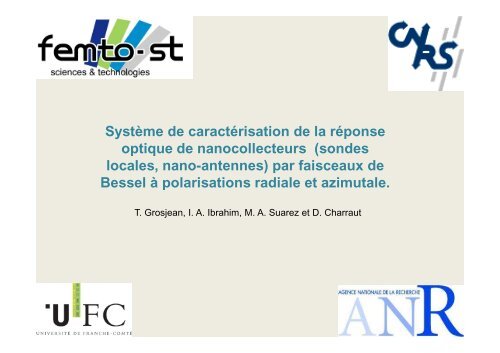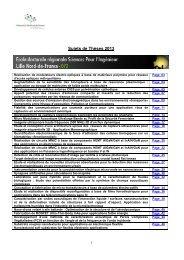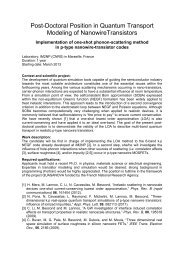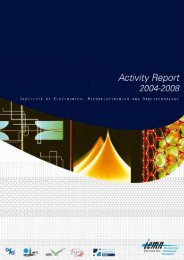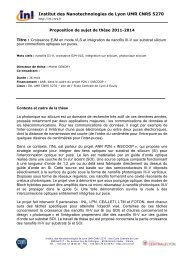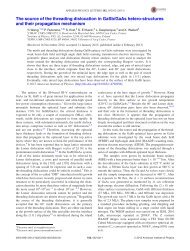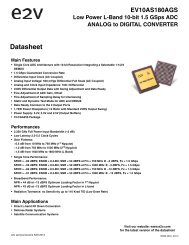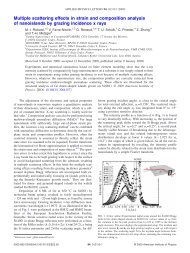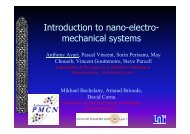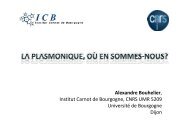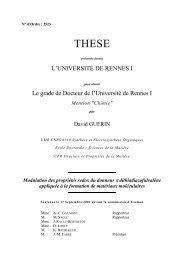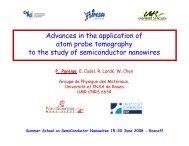par faisceaux de Bessel à polarisations radiale et azimutale ...
par faisceaux de Bessel à polarisations radiale et azimutale ...
par faisceaux de Bessel à polarisations radiale et azimutale ...
Create successful ePaper yourself
Turn your PDF publications into a flip-book with our unique Google optimized e-Paper software.
Système <strong>de</strong> caractérisation <strong>de</strong> la réponse<br />
optique <strong>de</strong> nanocollecteurs (son<strong>de</strong>s<br />
locales, nano-antennes) <strong>par</strong> <strong>faisceaux</strong> <strong>de</strong><br />
<strong>Bessel</strong> à <strong>polarisations</strong> <strong>radiale</strong> <strong>et</strong> <strong>azimutale</strong>.<br />
T. Grosjean, I. A. Ibrahim, M. A. Suarez <strong>et</strong> D. Charraut<br />
1
Introduction<br />
Nanophotonique : électromagnétisme optique à l’échelle submicronique<br />
• électromagnétisme sub-THz optique<br />
• résonnances électriques <strong>et</strong>/ou magnétiques locales , BIP, on<strong>de</strong>s <strong>de</strong> surfaces, <strong>et</strong>c.<br />
Nano-antennes, métamatériaux « main gauche », cristaux photoniques, <strong>et</strong>c…<br />
Caractérisation optique <strong>de</strong>s structures <strong>de</strong> la nanophotonique<br />
- Résolution sub-longueur d’on<strong>de</strong> Microscopie en champ proche<br />
- Détection électromagnétique complète <strong>de</strong>s structures (E <strong>et</strong> H)<br />
???<br />
Notre objectif<br />
Développer <strong>de</strong>s concepts <strong>de</strong> caractérisation électromagnétique (E <strong>et</strong> H) optique locale<br />
Point <strong>de</strong> dé<strong>par</strong>t<br />
Faisceau <strong>de</strong> <strong>Bessel</strong> + polarisation axiale (<strong>radiale</strong> ou <strong>azimutale</strong>)<br />
2
Plan <strong>de</strong> l’exposé<br />
1. Faisceaux <strong>de</strong> <strong>Bessel</strong> polarisés <strong>radiale</strong>ment <strong>et</strong> <strong>azimutale</strong>ment<br />
2. Intérêt <strong>de</strong>s <strong>faisceaux</strong> <strong>de</strong> <strong>Bessel</strong> polarisés <strong>radiale</strong>ment en SNOM<br />
2-1. Faisceau <strong>de</strong> <strong>Bessel</strong> évanescent: pointe virtuelle<br />
2.2. Obj<strong>et</strong>-test: réponse électromagnétique <strong>de</strong> nanocollecteurs<br />
A) Pointe SNOM<br />
B) Résine photosensible<br />
3. Intérêt <strong>de</strong>s <strong>faisceaux</strong> <strong>de</strong> <strong>Bessel</strong> polarisés <strong>azimutale</strong>ment en nano-optique<br />
Caractérisation d’une nano-antenne sur son<strong>de</strong> locale : « loop antenna » optique<br />
Création <strong>et</strong> caractérisation d’une boucle <strong>de</strong> courant optique<br />
3
1) Faisceaux <strong>de</strong> <strong>Bessel</strong> polarisés <strong>radiale</strong>ment <strong>et</strong> <strong>azimutale</strong>ment<br />
T 0 : J. Durnin, "Exact solutions for nondiffracting beams. I. The scalar theory", JOSA A, 4: 651 (1987)<br />
- Faisceau <strong>de</strong> <strong>Bessel</strong> = faisceau transmis <strong>par</strong> un « axicon »<br />
- « Axicon » = lentille conique ou prisme <strong>de</strong> révolution<br />
Cas du prisme<br />
Sinusoï<strong>de</strong><br />
Prisme<br />
01/04/2009 LASER<br />
4
1) Faisceaux <strong>de</strong> <strong>Bessel</strong> polarisés <strong>radiale</strong>ment <strong>et</strong> <strong>azimutale</strong>ment<br />
T 0 : J. Durnin, "Exact solutions for nondiffracting beams. I. The scalar theory", JOSA A, 4: 651 (1987)<br />
- Faisceau <strong>de</strong> <strong>Bessel</strong> = faisceau transmis <strong>par</strong> un « axicon »<br />
- « Axicon » = lentille conique ou prisme <strong>de</strong> révolution<br />
Cas <strong>de</strong> l’axicon<br />
Fonction <strong>de</strong> <strong>Bessel</strong><br />
Sinusoï<strong>de</strong> <strong>de</strong> révolution<br />
Prisme <strong>de</strong> révolution<br />
Axicon<br />
expérience<br />
01/04/2009<br />
LASER<br />
5
2) Faisceaux <strong>de</strong> <strong>Bessel</strong> polarisés <strong>radiale</strong>ment <strong>et</strong> <strong>azimutale</strong>ment<br />
Opt. Comm. 2005 Appl. Phys. L<strong>et</strong>t. 2008<br />
6
1) Faisceaux <strong>de</strong> <strong>Bessel</strong> polarisés <strong>radiale</strong>ment <strong>et</strong> <strong>azimutale</strong>ment<br />
1) Champs invariants selon la direction longitudinale <strong>de</strong> propagation<br />
2) Distributions <strong>de</strong> champ analytiques simples<br />
Polarisation<br />
<strong>radiale</strong><br />
E T ∝ J 1 (αr)<br />
E L ∝ J 0 (αr)<br />
H T ∝ J 1 (αr)<br />
H L = 0<br />
J 0<br />
2<br />
J 1<br />
2<br />
Polarisation<br />
<strong>azimutale</strong><br />
E T ∝ J 1 (αr)<br />
E L = 0<br />
H T ∝ J 1 (αr)<br />
H L ∝ J 0 (αr)<br />
3) Faisceaux focalisés optimisés = <strong>faisceaux</strong> <strong>de</strong> <strong>Bessel</strong> polarisés <strong>radiale</strong>ment<br />
Opt. Comm., 2007<br />
7
2) Intérêt <strong>de</strong>s <strong>faisceaux</strong> <strong>de</strong> <strong>Bessel</strong> polarisés <strong>radiale</strong>ment en SNOM<br />
2-1. Faisceau <strong>de</strong> <strong>Bessel</strong> évanescent: son<strong>de</strong> virtuelle<br />
Intérêt : Elimination <strong>de</strong>s couplages son<strong>de</strong>-échantillon, SNOM sans couplage ??<br />
Théorie<br />
Faisceaux <strong>de</strong> <strong>Bessel</strong> évanescents<br />
+ polarisation <strong>radiale</strong><br />
100 nm<br />
Expérience<br />
- Systèmes axiconique<br />
- Polariseur radial<br />
- Caractérisation <strong>par</strong> lithographie<br />
250 nm<br />
Z (a.u.)<br />
225 nm<br />
Theor<strong>et</strong>ical prediction :<br />
FWHM = 160 nm<br />
λ = 500 nm<br />
2.7 µm * 2.7 µm<br />
0 1 2<br />
8
2.2. Obj<strong>et</strong>-test: réponse électromagnétique <strong>de</strong> nanocollecteurs<br />
A) Pointe SNOM<br />
E T ∝ J 1<br />
E L ∝ J 0<br />
Scan 2D<br />
Pointe fibrée<br />
diélectrique<br />
« Plan obj<strong>et</strong> »:<br />
intensité<br />
simulation<br />
Image<br />
expérience<br />
Phys. Rev. E. 2003<br />
E T ∝ J 1<br />
4,8 µm* 4,8 µm 4,8 µm* 4,8 µm<br />
E L non restitué dans l’image<br />
Filtrage <strong>de</strong> polarisation<br />
9
2.2. Obj<strong>et</strong>-test: réponse électromagnétique <strong>de</strong> nanocollecteurs<br />
B) Résine photosensible<br />
Objectif initial : mise en évi<strong>de</strong>nce <strong>de</strong> l’intensité totale du champ (confinement lumineux )<br />
PMMA-DR1<br />
- Résine auto-développante: pas <strong>de</strong> phase <strong>de</strong> développement<br />
- Absorption dans le visible (400nm - 600 nm)<br />
- Matrice: PMMA, colorant: DR-1 (molécule azobenzénique)<br />
Utilisée en SNOM pour caractériser les son<strong>de</strong>s locales:<br />
S. Davy and M. Spajer, Appl Phys L<strong>et</strong>t 69 (1996) (22), pp. 3306–3308<br />
N. Landraud <strong>et</strong> al, Appl Phys L<strong>et</strong>t 79 (2001), pp. 4562–4564.<br />
F. H’dhili, <strong>et</strong> al. Appl Phys L<strong>et</strong>t 79 (2001) (24), pp. 4019–4021.<br />
- Dépôt en couche mince (épaisseur =<br />
100 nm) sur lame <strong>de</strong> verre trans<strong>par</strong>ente.<br />
- Eclairage en transmission, λ = 514 nm<br />
- Temps d’exposition 0.5 s, P < 1 mW<br />
10
|E T | 2 (Exp.)<br />
Polarisation <strong>radiale</strong><br />
|E L | 2 (Simu.)<br />
Topographie<br />
1µ<br />
m<br />
1µ<br />
m<br />
Polarisation circulaire<br />
|E T | 2 (Exp.)<br />
|E L | 2 (Simu.)<br />
Topographie<br />
1µ m<br />
1µ<br />
m<br />
Optics. Express. 2006<br />
Restitution <strong>de</strong> la composante longitudinale du champ<br />
électrique (E L ) perpendiculaire à la surface <strong>de</strong> la résine<br />
E L<br />
11
3) Intérêt <strong>de</strong>s <strong>faisceaux</strong> <strong>de</strong> <strong>Bessel</strong> polarisés <strong>radiale</strong>ment en nano-optique<br />
Nano-optique/nanophotonique :<br />
Cristaux photoniques, tamis à photons, métamatériaux « main-gauche », nano-antennes …<br />
[ E. Chow <strong>et</strong><br />
al., Opt. L<strong>et</strong>t.<br />
26, 286 (2001) ]<br />
P. Schuck <strong>et</strong> al,<br />
Phys. Rev. L<strong>et</strong>t.,<br />
94:17402, 2005<br />
Caractérisation optique <strong>de</strong>s structures <strong>de</strong> la nanophotonique<br />
- Résolution sub-longueur d’on<strong>de</strong> Microscopie en champ proche<br />
- Détection électromagnétique complète <strong>de</strong>s structures (E <strong>et</strong> H)<br />
|E| 2 |H| 2<br />
Comment se positionne le SNOM <strong>par</strong> rapport à<br />
c<strong>et</strong>te problématique ??<br />
12
3) Intérêt <strong>de</strong>s <strong>faisceaux</strong> <strong>de</strong> <strong>Bessel</strong> polarisés <strong>radiale</strong>ment en nano-optique<br />
<strong>azimutale</strong>ment<br />
Quelques exemples :<br />
Nano-antennes sur son<strong>de</strong>s SNOM fibrées<br />
J.N. Farahani & al. Phys. Rev. L<strong>et</strong>t. 95-2005<br />
T.Kalkbrenner & al. Phys.Rev.L<strong>et</strong>t. 95-2005<br />
Taminiau & al. NanoL<strong>et</strong>ters 7-2006<br />
13
3) Intérêt <strong>de</strong>s <strong>faisceaux</strong> <strong>de</strong> <strong>Bessel</strong> polarisés <strong>radiale</strong>ment en nano-optique<br />
<strong>azimutale</strong>ment<br />
Une première réalisation<br />
Nano-antenne annulaire<br />
« Loop antenna » optique<br />
Caractérisation <strong>par</strong><br />
faisceau <strong>de</strong> <strong>Bessel</strong><br />
polarisé <strong>azimutale</strong>ment<br />
polychromatique<br />
λ= 573 nm λ= 603 nm<br />
MIMENTO<br />
Collection<br />
λ= 620 nm λ= 648 nm<br />
sélective <strong>de</strong> H L<br />
J. Microsc., 2008<br />
|E tot | 2 , |H T | 2 |H tot | 2<br />
|H L | 2<br />
14


